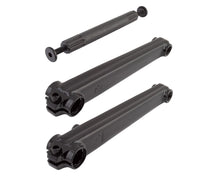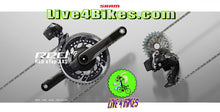SE Racing V-Ridge Cranks: A Durable Choice for BMX Enthusiasts
Introduction
When it comes to BMX biking, having the right equipment is essential for achieving peak performance and safety. The SE Racing V-Ridge Cranks are a standout choice for riders who demand strength, durability, and reliability. In this article, we'll provide a detailed description of these cranks, highlighting their features and specifications that make them an excellent choice for BMX enthusiasts.
Unique V-Ridge Tubing for Extra Strength
One of the standout features of the SE Racing V-Ridge Cranks is their unique V-Ridge tubing. This specialized design results in extra strength and less flex in the crank arms, which is crucial for BMX riders who put their equipment to the test with high-intensity tricks and jumps. The V-Ridge tubing not only enhances the structural integrity of the cranks but also contributes to a more responsive and efficient ride.
High-Quality Construction
These cranks are constructed from tubular 4130 chromoly arms. Chromoly is a popular choice for BMX components due to its exceptional strength-to-weight ratio. The 4130 chromoly used in the SE Racing V-Ridge Cranks ensures they can withstand the rigors of BMX riding, making them a reliable option for both beginners and experienced riders.
Cold Forged 19mm 8-Spline Spindle
The SE V-Ridge Cranks feature a cold-forged 19mm 8-spline spindle, adding another layer of durability to the crankset. Cold forging is a manufacturing process that strengthens the material and provides a consistent, high-quality finish. The 8-spline design ensures a secure connection between the spindle and the crank arms, reducing the risk of slippage and damage during aggressive riding.
SE Wing Logo Compression Bolt
The inclusion of the SE Wing Logo compression bolt not only adds a touch of branding to the cranks but also enhances their functionality. The compression bolt secures the crank arms in place, minimizing any unwanted movement during your ride. This stability is crucial for maintaining control and maximizing power transfer.
Specifications
The SE Racing V-Ridge Cranks are available in black, offering a sleek and classic appearance that complements a wide range of BMX bike designs. Here are some key specifications of these cranks:
- Spindle: 19mm
- Spindle Length: 5.75"
- Spindle Splines: 8 Spline
- Drive Side Compatibility: Right
- Sprocket Bolt: 10 x 1.5mm
- Color: Black
The 19mm spindle diameter is an industry-standard size, ensuring compatibility with a variety of bottom brackets and sprockets. The 5.75" spindle length provides the right balance between strength and weight, making these cranks suitable for both racing and freestyle BMX disciplines.
Conclusion
The SE Racing V-Ridge Cranks are a top choice for BMX enthusiasts who demand the best in terms of strength, durability, and performance. With their unique V-Ridge tubing, high-quality chromoly construction, cold-forged spindle, and secure compression bolt, these cranks are built to withstand the challenges of BMX riding.
Whether you're a seasoned pro or just starting your BMX journey, these cranks will provide the confidence and reliability you need to push your limits and reach new heights in your riding. The SE Racing V-Ridge Cranks are a testament to the company's commitment to quality and innovation, making them a worthwhile investment for any BMX rider.


When it comes to optimizing the performance of your bicycle, choosing the right cranks and bottom bracket is paramount. These components play a crucial role in power transmission and overall efficiency. In this guide, we'll explore the various types of cranks and bottom brackets available, and provide insights on how to select the perfect combination for your specific bike.

Types of Cranks
1. Square Taper
The square taper is one of the earliest designs and is characterized by a square-shaped interface between the crank arm and the bottom bracket spindle. It's a robust and reliable system, commonly found on older bikes. While it may lack some of the modern refinements, it remains a popular choice for many enthusiasts.
2. Octalink
Introduced by Shimano, the Octalink system features eight splines on the crank arm that engage with corresponding splines on the bottom bracket spindle. This design provides a more secure connection and improved power transfer compared to square taper designs.
3. Hollowtech II
Hollowtech II cranks, also from Shimano, utilize a two-piece design with an external bottom bracket. This design reduces weight and enhances stiffness, resulting in improved power transfer and efficiency. They are widely used in modern high-performance bikes.
4. ISIS Drive
ISIS (International Splined Interface Standard) Drive cranks feature a 10-spline interface, providing a large contact area between the crank arm and spindle. This design offers excellent stiffness and is commonly found on mountain bikes.
5. **BB30 and PressFit 30
BB30 and PressFit 30 bottom brackets have larger bearings and a larger spindle diameter than standard designs. This reduces weight and increases stiffness, providing enhanced power transfer. They are popular choices for high-end road and mountain bikes.

Types of Bottom Brackets
1. Threaded (BSC)
Threaded bottom brackets are the traditional type, screwing directly into the frame's threaded shell. They are reliable and easy to install, making them a popular choice for a wide range of bikes.
2. PressFit
PressFit bottom brackets are pressed directly into the frame, eliminating the need for threads. This design allows for a larger diameter spindle, resulting in increased stiffness and weight savings.
T47 is a newer standard that combines the benefits of threaded and PressFit designs. It utilizes a threaded shell but with a larger diameter, allowing for larger bearings and improved stiffness.
Choosing the Right Combination
Selecting the correct cranks and bottom bracket depends on various factors:
1. Frame Compatibility
Ensure the bottom bracket is compatible with your frame. Different frames have specific bottom bracket shell widths and threading standards.
2. Crankset Type
Choose a crankset that matches your riding style. For example, if you're into high-performance road cycling, a lightweight, stiff crankset like Hollowtech II might be ideal.
3. Budget and Weight Considerations
Higher-end materials and designs often come at a premium. Consider your budget and whether shaving off a few grams is critical for your riding goals.
4. Maintenance and Durability
Consider the maintenance requirements and durability of the chosen system. Some designs may require more attention and servicing than others.
Conclusion
Selecting the right cranks and bottom bracket for your bike is a crucial step towards optimizing performance. Understanding the various types and their benefits will help you make an informed decision. Always consult with a professional or refer to the manufacturer's recommendations for compatibility and installation guidelines. With the right combination, you'll experience a smoother, more efficient ride, whether you're cruising on the road or tackling rugged trails.


Tools Needed:
1. Crank puller tool
2. Allen wrench or wrench (for some models)
3. Adjustable wrench (if needed)
Steps:
1. Prepare Your Workspace:
- Find a clean, well-lit area to work.
- Make sure you have enough space to maneuver around the bike.
- Consider placing a towel or mat underneath to catch any small parts that might fall.
2. Shift the Gears:
- Shift the chain onto the smallest chainring and smallest rear cog. This relieves tension on the chain, making it easier to work.
3. Remove the Crank Bolts:
- Use an Allen wrench or wrench (depending on your crankset) to remove the bolts securing the crank arms to the spindle. These are typically located on the non-drive side.
4. Install the Crank Puller:
- Take your crank puller tool and thread it into the crank arm that you want to remove. Make sure it's screwed in securely but not so tight that it damages the threads.
5. Use the Crank Puller:
- Turn the handle of the crank puller clockwise. This will push against the spindle, gradually pulling the crank arm off. If it's difficult to turn, make sure you've threaded the tool in correctly.
6. Repeat for the Other Side:
- Move to the other side of the bike and repeat steps 3-5.
7. Remove the Crank Arms:
- Once the crank arms are pulled off, they should slide easily off the spindle. Be careful not to drop them.
8. Clean and Inspect:
- Take this opportunity to clean the crank arms and the bottom bracket area. Inspect the bottom bracket and spindle for any signs of wear or damage.
9. Reassembly (if necessary):
- If you're replacing the crankset, follow the reverse steps to install the new one. Make sure to properly torque the bolts to the manufacturer's specifications.
Remember, if you're unsure about any step or if your bike has unique components, it's always best to consult the specific manual for your bicycle or seek assistance from a professional at a bike shop. Additionally, having the right tools is crucial for this job, so make sure you're using the appropriate crank puller for your specific crankset.





